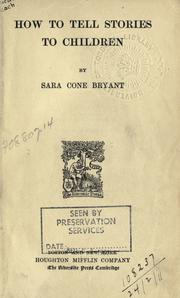Buy this book

The great difference between telling and reading is that the teller is free; the reader is bound. The book in hand, or the wording of it in mind, binds the reader. The story-teller is bound by nothing; he stands or sits, free to watch his audience, free to follow or lead every changing mood, free to use body, eyes, voice, as aids in expression. Even his mind is unbound, because he lets the story come in the words of the moment, being so full of what he has to say. For this reason, a story told is more spontaneous than one read, however well read. And, consequently, the connection with the audience is closer, more electric, than is possible when the book or its wording intervenes.Beyond this advantage, is the added charm of the personal element in story-telling. When you make a story your own and tell it, the listener gets the story, plus your appreciation of it. It comes to him filtered through your own enjoyment. That is what makes the funny story thrice funnier on the lips of a jolly raconteur than in the pages of a memoir. It is the filter of personality. Everybody has something of the curiosity of the primitive man concerning his neighbour; what another has in his own person felt and done has an especial hold on each one of us. The most cultured of audiences will listen to the personal reminiscences of an explorer with a different tingle of interest from that which it feels for a scientific lecture on the results of the exploration. The longing for the personal in experience is a very human longing. And this instinct or longing is especially strong in children. It finds expression in their delight in tales of what father or mother did when they were little, of what happened to grandmother when she went on a journey, and so on, but it also extends to stories which are not in themselves personal.The greater ease in holding the attention of children is, for teachers, a sufficient practical reason for telling stories rather than reading them. It is incomparably easier to make the necessary exertion of "magnetism," or whatever it may be called, when nothing else distracts the attention. One's eyes meet the children's gaze naturally and constantly; one's expression responds to and initiates theirs without effort; the connection is immediate. For the ease of the teacher, then, no less than for the joy of the children, may the art of story-telling be urged as pre-eminent over the art of reading.It is a very old, a very beautiful art. Merely to think of it carries one's imaginary vision to scenes of glorious and touching antiquity. The tellers of the stories of which Homer's Iliad was compounded; the transmitters of the legend and history which make up the Gesta Romanorum; the travelling raconteurs whose brief heroic tales are woven into our own national epic; the grannies of age-old tradition whose stories are parts of Celtic folk-lore, of Germanic myth, of Asiatic wonder-tales, - these are but younger brothers and sisters to the generations of story-tellers whose inventions are but vaguely outlined in resultant forms of ancient literatures, and the names of whose tribes are no longer even guessed.
Buy this book

Showing 9 featured editions. View all 9 editions?
| Edition | Availability |
|---|---|
| 1 |
zzzz
Libraries near you:
WorldCat
|
| 2 |
zzzz
Libraries near you:
WorldCat
|
| 3 |
cccc
Libraries near you:
WorldCat
|
| 4 |
zzzz
|
| 5 |
zzzz
|
| 6 |
zzzz
Libraries near you:
WorldCat
|
| 7 |
zzzz
|
| 8 |
zzzz
Libraries near you:
WorldCat
|
| 9 |
aaaa
|
Book Details
Edition Notes
The Physical Object
ID Numbers
Community Reviews (0)
Feedback?| July 22, 2019 | Edited by MARC Bot | remove fake subjects |
| December 4, 2010 | Edited by Open Library Bot | Added subjects from MARC records. |
| June 23, 2010 | Edited by ImportBot | add description and subjects from OverDrive |
| May 6, 2010 | Edited by EdwardBot | add Accessible book tag |
| December 10, 2009 | Created by WorkBot | add works page |












